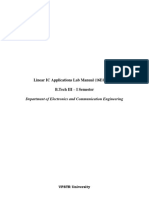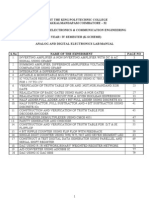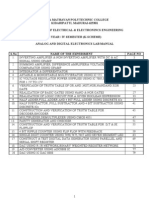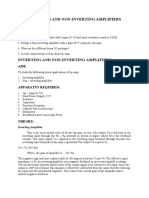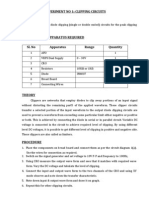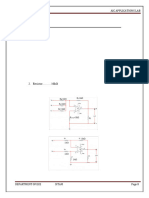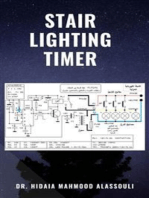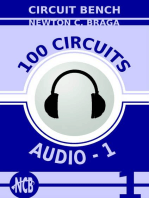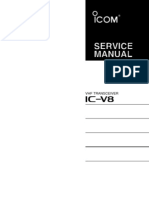LIC Lab Manual
LIC Lab Manual
Uploaded by
sfundsCopyright:
Available Formats
LIC Lab Manual
LIC Lab Manual
Uploaded by
sfundsOriginal Description:
Copyright
Available Formats
Share this document
Did you find this document useful?
Is this content inappropriate?
Copyright:
Available Formats
LIC Lab Manual
LIC Lab Manual
Uploaded by
sfundsCopyright:
Available Formats
EC 6412 - Linear Integrated Circuits Lab II yr/IV sem
LINEAR INTEGRATED CIRCUITS LABORATORY
BREAD BOARDING TECHNIQUES
1. Do all the wiring with power switched off.
2. Keep wiring and component lead as short as possible.
3. Wire the +V (positive voltage) and V (negative voltage) supply leads to the opamp first.
4. Follow color coding for power supply connections
a. Red
+15V
b. Black
-15V
c. Green
Ground
5. Tie all the grounds to a common point, the power supply ground.
6. Recheck all the wiring before switching on.
7. Connect signal voltage only after power is switched on.
8. Take all measurements with reference to power supply ground.
9. Disconnect signal voltage before switching off power.
Dept Of ECE
EASWARI ENGINEERING COLLEGE
Page 1
EC 6412 - Linear Integrated Circuits Lab II yr/IV sem
THE FOLLOWING GENERAL PURPOSE LINEAR ICs WILL BE USED IN THE
INTEGRATED CIRCUITS LABORATORY
IC 741
PIN CONFIGURATION
CHARACTERISTICS OF 741 C:
Supply voltage
15 V to 18V
Power dissipation
500mw
Differential input voltage
30V
Normally used supply voltage:
15V
Operating temperature
0 to 70 degree C
Offset voltage
2mV to 6mV
Offset current
20nA to 200nA
Input bias current
80nA to 500nA
Output Voltage swing
14V
Large signal voltage gain
200
Power supply rejection ratio :
10V / V to 150V /V
Common mode rejection ratio:
70 90 dB
Power consumption
50mW to 85mW
Slew rate
0.5 to 0.8 V/V
Unity gain band width
1 MHz
Dept Of ECE
EASWARI ENGINEERING COLLEGE
Page 2
EC 6412 - Linear Integrated Circuits Lab II yr/IV sem
IC 555 TIMER
CHARACTERISTICS OF NE 555:
Supply voltage
+5V to 16V
Power dissipation
600mW
Operating temperature
0 to 70 oC
Normally used supply voltage
+5V
Control voltage level
+9V to +11V for +15 V supply
+2.6V to +4V for +5V supply
Threshold voltage level
+8.8 V to 11.2V for +15V supply
+2.4 V to +4.2V for +5V supply
Trigger voltage
+4.5V to 5.6V for +15V supply
+1.1V to +2.2V for +5V supply
IC NE 565 PHASE LOCKED LOOP
Dept Of ECE
EASWARI ENGINEERING COLLEGE
Page 3
EC 6412 - Linear Integrated Circuits Lab II yr/IV sem
-V
No connection
Input
No connection
Input
NE 565
VCO output
No connection
No connection
V+
Phase Comparator VCO output
Reference output
EXTERNAL CAPACITOR FOR VCO
Demodulated output
EXTERNAL RESISTOR FOR VCO
CHARACTERISTICS OF NE 565:
Supply Voltage
6V to 26V
Power dissipation
300mW
Operating temperature
0 to 70 oC
Normally used supply voltage:
6V to 12V
IC 723 VOLTAGE REGULATOR
No connection
No Connection
Current Limit
Current Sense
Inverting Input
Frequency Compensation
723
V+
VC
V OUT
Phase Comparator VCO Input
VZ
1. DESIGN OF INVERTING AND NON INVERTING AMPLIFIER USING IC 741
Dept Of ECE
EASWARI ENGINEERING COLLEGE
Page 4
EC 6412 - Linear Integrated Circuits Lab II yr/IV sem
AIM:
To design and study the working of inverting and non-inverting amplifier using IC 741.
APPARATUSREQUIRED:
Signal Generator, IC 741, CRO, CRO probes, resistors and connecting wires
CIRCUIT DIAGRAM:
DESIGN EQUATIONS:
Inverting Amplifier: Gain = -Rf/ Ri
Non inverting amplifier: Gain = 1 + Rf/ Ri
DESIGN:
INV-AMP:
GIVEN DATA:GAIN = 10, Ri = 1K
GAIN = -Rf/Ri=>Rf= 10x1K =>Rf= 10K
NON-INV AMP:
GIVEN DATA:GAIN = 11, Ri = 1K
GAIN = 1+Rf/Ri =>11= 1+Rf/1k=>Rf= 10K
Dept Of ECE
EASWARI ENGINEERING COLLEGE
Page 5
EC 6412 - Linear Integrated Circuits Lab II yr/IV sem
THEORY:
INVERTING AMPLIFIER
The output of an amplifier is inverted as compared to the input signal. The inverted output
means having a phase shift of 1800 as compared to the input signal. The voltage gain depends on the
ratio of two resistances Rf and Ri. If Rf>Ri the gain is greater than 1 and if Rf<Rithe gain will be less
than 1.
NON-INVERTING AMPLIFIER
An amplifier which amplifies the input without producing any phase shift between input and
output is called non-inverting amplifier. The voltage gain is always greater than 1. It can be used as a
buffer for impedance matching.
PROCEDURE:
1. Connect the circuit as per the circuit diagram.
2. Apply an ac signal of amplitude 1V peak to peak at 1 KHz as the input
3. Observe the output wave form. Note the amplitude and frequency of the output waveform.
4. Calculate the theoretical and practical gain and tabulate the results.
5. Repeat the experiment for different values of Rf and Ri.
6. Repeat the entire procedure for non inverting amplifier.
TABULATIONS:
Inverting amplifier:
Vin = 1V p-p
Rf()
Dept Of ECE
Ri()
Vin (V)
Vout (V)
Theoretical Gain
EASWARI ENGINEERING COLLEGE
Practical
Gain
Page 6
EC 6412 - Linear Integrated Circuits Lab II yr/IV sem
Non-inverting amplifier:
Vin = 1V p-p
Rf()
Ri()
Vin (V)
Vout (V)
Theoretical Gain
Practical
Gain
MODEL GRAPH:
VIVA QUESTIONS:
1. What is an Op-amp? Draw
the pin diagram of IC 741.
2. What are the applications
of an op-amp?
3. Define inverting, Noninverting and differential
amplifier.
4. Difference between
inverting and non-inverting amplifier.
5. If the ratio of Rf and Ri is K(constant)in inverting amplifier then the circuit is called as------RESULT:
Thus inverting and non-inverting amplifier was designed and studied and the graph was
obtained.
2. DESIGN OF AN INTEGRATOR AND DIFFERENTIATOR USING IC 741
AIM:
Dept Of ECE
EASWARI ENGINEERING COLLEGE
Page 7
EC 6412 - Linear Integrated Circuits Lab II yr/IV sem
To design and study an integrator and differentiator using IC 741
APPARATUSREQUIRED:
Signal Generator, IC 741, CRO, CRO probes, resistors, capacitorsand connecting wires
CIRCUIT DIAGRAM:
DESIGN EQUATIONS
fa =1/ 2RfCi
fb = 1/ 2RiCi
fb = 10fa , RiCi = RfCf
DESIGN:
GIVENDATA:fa = 100 Hz , Ci=0.1F
From fa =1/ 2RfCi
100= 1/2Rf x0.1x10-6
=>Rf= 1/2x500 x0.1x10-6= 15.9 K
fb = 10fa= 1KHz
From fb = 1/ 2RiCi
=>Ri = 1/ 2x1x103 x0.1x10-6
=1.59 K
Rcomp=RixRf/ (Ri+Rf) =
1.5K
FromRiCi = RfCf
Dept Of ECE
EASWARI ENGINEERING COLLEGE
Page 8
EC 6412 - Linear Integrated Circuits Lab II yr/IV sem
Cf =RiCi/Rf
Cf = 1.59x103 x0.1x10-6/ 15.9x103 = 0.01f
THEORY:
INTEGRATOR
A simple low pass RC circuit can also work as an integrator when time constant is very large.
This requires very large values of R and C.The components R and C cannot be made infinitely large
because of practical limitations. However in the op-amp integrator by MILLERs theorem, the effective
input capacitance becomes Cf (1-Av), where Av is the gain of the op-amp. The gain Av is infinite for an
ideal op-amp, so the effective time constant of the opamp integrator becomes very large which results in
perfect integration.
DIFFERENTIATOR
The circuit performs the mathematical operation of differentiation i.e. the output waveform is the
derivative of the input waveform. The input signal is given to the inverting terminal through a capacitor.
When it is used at high frequencies it may become unstable and break into oscillation because as the
frequency increases gain also increases and the circuit looses stability. In order to overcome this
difficulty practical differentiator are used.
PROCEDURE:
1. Differentiator:
a. Connect the circuit as per the circuit diagram with the designed values
b. Observe the output for various input wave forms ( Sinusoidal and square waveforms for
desired frequencies)
2. Integrator:
a. Connect the circuit as per the circuit diagram with the designed values
b. Observe the output for various input wave forms ( Sinusoidal and square waveforms for
desired frequencies)
TABULATIONS:
INTEGRATOR
Dept Of ECE
EASWARI ENGINEERING COLLEGE
Page 9
EC 6412 - Linear Integrated Circuits Lab II yr/IV sem
Square Wave
Input
Amplitude
Time (s)
(V)
Sine wave
Output
Amplitude
Time (s)
(V)
Input
Amplitude
Time (s)
Output
Amplitude
Time (s)
(V)
(V)
DIFFERENTIATOR
Square Wave
Input
Amplitude
Time (s)
(V)
Sine wave
Output
Amplitude
Time (s)
(V)
Input
Amplitude
Time (s)
Output
Amplitude
Time (s)
(V)
(V)
MODEL GRAPHS:
Integrator:
Differentiator:
Viva questions:
Dept Of ECE
EASWARI ENGINEERING COLLEGE
Page 10
EC 6412 - Linear Integrated Circuits Lab II yr/IV sem
1. Define integrator and differentiator.
2. List the types of integrator.
3. Write the applications of integrator and differentiator.
4. What are the disadvantages of differentiator?
RESULT:
Thus integrator and differentiator was designed and the corresponding graph was drawn.
3.DESIGN OF DIFFERENTIAL AND INSTRUMENTAION AMPLIFIER
AIM:
To design an differential and instrumentation amplifier and to study its operation
APPPARATUS:
CRO, potentiometer, resistors and capacitors, IC 741, CRO probes and connecting wires
CIRCUIT DIAGRAM
DIFFERENTIAL AMPLIFIER
Dept Of ECE
EASWARI ENGINEERING COLLEGE
Page 11
EC 6412 - Linear Integrated Circuits Lab II yr/IV sem
INSTRUMENTATION AMPLIFIER
DESIGN EQUATIONS:
Instrumentation amplifier A = Vout / e2 e1 = ( R4 / R3 ) ( 1 + 2 R2 / R1 )
Differential amplifier Vo = R2/R1 (V2 V1)
DESIGN:
Differential amplifier:
Given data : v1 = 20mv, v2 = 25mv, R1= 1k, R2 = 3.6 k
Vo = R2/R1 (V2 V1) = 3.6 k/1k ( 25x10-3 20x10-3)
= 18mv
Instrumentation amplifier : R1 = 2k, R2 = R3 = 10k, R4 = 22k, e1 = 20mv, e2 = 25mv
Given data : R1 = 2k, R2 = R3 = 10k, R4 = 22k, e1 = 20mv, e2 = 25mv
A = ( R 4 / R3 ) ( 1 + 2 R 2 / R1 )
= (22k/10k)(1+ 20k/2k)
= 24.2
THEORY:
They are used to amplify the low level differential signals very precisely in presence of the large
common mode noise and interference signals. It has finite accurate and stable gain, high input
impedance, low output impedance, high CMRR, high slew rate and low power consumption. The
commonly used instrumentation amplifier is one using 3 op amps. In this circuit a non-inverting
amplifier is added to each of the basic differential amplifier inputs.
Differential amplifier is to amplify the difference between the inputs and the gain is depend on
resistor R2 and R1.
Dept Of ECE
EASWARI ENGINEERING COLLEGE
Page 12
EC 6412 - Linear Integrated Circuits Lab II yr/IV sem
PROCEDURE: Instrumentation amplifier
1. Connect the circuit as per the circuit diagram
2. Set the inputs e1 and e2 at different values but at the same frequency
3. Calculate the theoretical gain from the given formula and verify with the practical values
PROCEDURE: Differential amplifier
1. Connect the circuit as per the circuit diagram
2. Set the inputs v1 and v2 at different values but at the same frequency
3. Calculate the theoretical gain from the given formula and verify with the practical values
TABULATION:
E1 (V)
E2 (V)
Theoretical gain
Practical gain
v1 (V)
v2 (V)
Theoretical gain
Practical gain
Model Graph:
Differential amplifier
Dept Of ECE
EASWARI ENGINEERING COLLEGE
Page 13
EC 6412 - Linear Integrated Circuits Lab II yr/IV sem
Vo(volts)
Instrumentation
amplifier
Vo(volts)
Viva questions:
1. What is an
2.
3.
4.
5.
instrumentation amplifier
Give the other name of instrumentation amplifier
Write the requirements of good instrumentation amplifier.
List the applications of instrumentation amplifier.
Specify some application of differential amplifier
RESULT :
Thus instrumentation amplifier and differential amplifierwas designed and studied.
4. ACTIVE LOWPASS, HIGH PASS AND BAND PASS FILTER USING IC 741C
AIM:
To design a first order active low pass, high pass and band pass filter using IC 741
APPARATUSREQUIRED:
Signal Generator, IC 741, CRO, CRO probes, resistors, capacitors and connecting wires
CIRCUIT DIAGRAM:
Dept Of ECE
EASWARI ENGINEERING COLLEGE
Page 14
EC 6412 - Linear Integrated Circuits Lab II yr/IV sem
HIGH PASS FILTER
DESIGN EQUATIONS:
Low pass filter:
fh= 1 / 2RiC
High pass filter: fl
= 1 / 2 R2C2, Rf = Ri
Band pass filter: Rf = Ri
fh = 1 / 2 R1C1
fl = 1 / 2 R2C2
Design:
LPF:
Given data : Fh = 9Khz, C= 0.01 F
9x103 = 1/2xx Rix 0.01x10-6
Ri = 1.7k
HPF:
Given data : Fl = 1Khz ,C= 0.1 F, Ri = 10k
1 x103= 1/2xx R2x 0.1x10-6
R2 =15.9 K
BPF:Fh = 9Khz, Fl = 1KHz ,C= 0.01 F, Rf=Ri = 10k
Dept Of ECE
EASWARI ENGINEERING COLLEGE
Page 15
EC 6412 - Linear Integrated Circuits Lab II yr/IV sem
using
fh = 1 / 2 R1C1
9x103 = 1/2xx Rix 0.01x10-6
R1 = 1.7k
Using fl = 1 / 2 R2C2
1 x103= 1/2xx R2x 0.1x10-6
R2 =15.9 K
THEORY:
Afilter is a circuit that is designed to pass a specified band of frequencies. The low pass filter
have a constant gain from a lower cut off frequencies to higher cutoff frequency f h. Hence the
bandwidth of the filter is fh. The circuit allows the range of frequency from 0 to f h, this range is known
as pass band. The range of frequency beyondf his completely attenuated and called as stop
band.Practically gain of the filter decreases as the frequency increases and at f= f h the gain is down by
3db.
PROCEDURE:
1. Connect the circuit as per the designed values
2. Give a sinusoidal input of say 1V p-p
3. Vary the input frequency at regular intervals and note down the output response from CRO
4. Plot the frequency response on a semi log sheet
5. Verify the practical and theoretical cut-off frequency
6. Repeat the above procedure for the high and band pass filter.
Tabulations:
Low-pass filter
Vin =1Vp-p
F(Hz)
Vo (V)
A (dB)
Vo (V)
A (dB)
High-pass filter
Vin =1Vp-p
F (Hz)
Dept Of ECE
EASWARI ENGINEERING COLLEGE
Page 16
EC 6412 - Linear Integrated Circuits Lab II yr/IV sem
Band-pass filter
Vin = 1Vp-p
F (Hz)
Vo (V)
A (dB)
Model graph:
Low Pass Filter
High Pass Filter
Gain
(dB)
Band Pass Filter
Hz
Gain
(dB)
Viva questions:
1. Define filters.
2. Define active
and passive
filters.
3. List the
advantages of
active filters
4. Write the
different types
of filters
5. Draw the ideal and practical characteristics of filter
Dept Of ECE
EASWARI ENGINEERING COLLEGE
Page 17
Hz
EC 6412 - Linear Integrated Circuits Lab II yr/IV sem
RESULT:
Thus Low pass, High pass and Band pass Filter was designed and corresponding graph was
drawn.
5.ASTABLE MULTIVIBRATOR USING IC 741C
AIM:
To design and study an astable multivibrator using IC 741
APPARATUSREQUIRED:
IC 741, CRO, CRO probes, resistors, capacitors and connecting wires
CIRCUIT DIAGRAM:
DESIGN
EQUATIONS:
Total time
period =
2RCln[(1+) /
( 1-)]
= R 2 / R1 + R 2
R1 = 1.16
R2
Design:
Given data :F= 1K, R2 = 10K, C = 0.05 f
R1= 1.16x10k = 11.6k
= R 2 / R1 + R 2
= 10/21.6= 0.46
T=1/f
1/ 1x103=2xRx 0.05x10-6x ln( 1.46/0.54)
R = 10k
THEORY:
Dept Of ECE
EASWARI ENGINEERING COLLEGE
Page 18
EC 6412 - Linear Integrated Circuits Lab II yr/IV sem
A simple op-amp square wave generator is also called as free running oscillator. The principle
of generation of square wave output is to force an op-amp to operate in the saturation region. A fraction
=R2/(R1+R2) of the output is fed back to the (+) input terminal. The output is also fed to the (-)
terminal after integrating by means of a low pass RC combination in astablemultivibrator. Both the
states are quasistable state. The frequency is determined by the time taken by the capacitor to charge
from- Vsat to+Vsat and vice-versa.
PROCEDURE:
1. Make the connections as per the circuit diagram
2. Observe the output waveform at pin 6 and note the frequency of the waveform
3. Compare the theoretical and practical frequencies
4. Plot the waveforms at pins 6 and 2 (across the capacitor)
Tabulations:
Parameter
Square Wave
Amplitude (V)
Time (s)
Charging and discharging
MODEL GRAPH
Viva questions:
1. Define
multivibrators.
2. Difference
between
Monostable and
Astable
Multivibrators
3. Give the other name of astable multivibrators.
RESULT:
Thus the Astable Multivibrator using IC 741 was designed and the output waveform was
obtained.
6. MONOSTABLE MULTIVIBRATOR USING IC 741
Dept Of ECE
EASWARI ENGINEERING COLLEGE
Page 19
EC 6412 - Linear Integrated Circuits Lab II yr/IV sem
AIM:
To design and study a monostablemultivibrator using IC 741
APPARATUSREQUIRED:
Signal Generator, IC 741, CRO, CRO probes, resistors, capacitors, IN 4001 diode and
connecting wires
CIRCUIT DIAGRAM:
DESIGN
EQUATIONS:
T = 0.693 Rf C
R1 = 10 R2
DESIGN:
Given data: F = 500 Hz, R2 = 10k, C= 0.01 f
R1 = 100k
T =1/f
Rf= 1/(0.693x500x0.01x10-6)
=289k
THEORY
The diode D1 is clamping the capacitor voltage to 0.7v when the output is at +vsat. The circuit
produces a single pulse of specified duration in response to each external trigger signal. For such a
circuit only one stable state exists. When an external trigger is applied the output changes its stable
Dept Of ECE
EASWARI ENGINEERING COLLEGE
Page 20
EC 6412 - Linear Integrated Circuits Lab II yr/IV sem
state. The circuit remains in this state for a fixed interval of time. Usually the charging and discharging
of the capacitor provides this internal trigger signal.
PROCEDURE:
1. Connect the circuit as per the circuit diagram
2. Give negative trigger pulse at the input
3. Observe output waveform (one stable state) at pin 6
4. Plot the input and output waveforms.
5. Also plot the waveform across the capacitorC that connected with Rf.
Tabulations:
Parameter
Input
Amplitude (V)
Time (s)
Output at Pin 2
Output at Pin 6
MODEL GRAPH:
RESULT :
Thus the
operation
of
monostable
multivibrator was studied and the graph was drawn.
Viva Questions:
1. Define time constant
2. What is the condition for a multivibrator to operate in monostable mode?
3. What are the applications of Monostable Multivibrator?
7. SCHMITT TRIGGER USING IC741
Dept Of ECE
EASWARI ENGINEERING COLLEGE
Page 21
EC 6412 - Linear Integrated Circuits Lab II yr/IV sem
AIM:
To study the characteristics of a Schmitt trigger using IC 741
APPARATUSREQUIRED:
Signal Generator, IC 741, CRO, CRO probes, resistors and connecting wires
CIRCUIT DIAGRAM:
DESIGN
EQUATIONS:
Vsat =
12V
VUTP = VLTP =
R1 (Vsat / R1 + R2 )
Design:
Given data : VUTP = 0.5 v , R1 = 1K
FromVUTP= R1 (Vsat / R1 + R2 )
0.5 = 1x103(12/103+R2)
=> R2 =23k
R= R1xR2/(R1+R2)
R = 1k
THEORY:
Schmitt trigger is useful in squaring of slowly varying i/p waveforms. Vin is applied to inverting
terminal of op-amp. Feedback voltage is applied to the non-inverting terminal. LTP (low threshold
point)is the point at which output changes from high level to low level .This is highly useful in
triangular waveform generation, wave shape pulse generator, A/D convertor etc.
PROCEDURE:
1.Connect the circuit as per the circuit diagram
2.Set input signal, say, 1V, 1KHz using signal generator
3.Observe the input and output waveform.
Dept Of ECE
EASWARI ENGINEERING COLLEGE
Page 22
EC 6412 - Linear Integrated Circuits Lab II yr/IV sem
4.Compare with the theoretical value of LTP and UTP.
Tabulation:
Parameter
Input
Amplitude (V)
Time (s)
Output
MODEL GRAPH:
Viva questions:
1. Define Schmitt
trigger
2. Write the
applications of Schmitt
trigger.
3. Write the type of
Feedback used in
Schmitt trigger(opamp).
RESULT:
Thus the characteristics of Schmitt trigger was studied and the graph was plotted.
8.DESIGN OF AN RC PHASE SHIFT OSCILLATOR USING IC 741
AIM:
To design an RC phase shift oscillator using IC 741.
APPARATUSREQUIRED:
IC 741, CRO, CRO probes, resistors, capacitors and connecting wires
CIRCUIT DIAGRAM:
Dept Of ECE
EASWARI ENGINEERING COLLEGE
Page 23
EC 6412 - Linear Integrated Circuits Lab II yr/IV sem
DESIGN
EQUATIONS:
fo = 1 / 6 (2 R C )
Rf= 29 Ri, Ri =10 R
DESIGN:
Given data :Fo = 650 Hz, C = 0.1f
From fo = 1 / 6 (2 R C )
650 = 1/ 6 ( 2xxRx 0.1x10-6)
R = 1k
Ri = 10k
Rf = 290 k
THEORY:
Positive feedback of a fraction of output voltage of a amplifier fed to the input in the same
phase, will generate sine wave. The op-amp provides a phase shift of 180 0 degree as it is used in the
inverting mode. An additional phase shift of 180 degree is provided by the feedback RC network. The
frequency of the oscillator fo is given by
fo = 1 / 6 (2 R C )
Also the gain of the inverting op-amp should be atleast 29orRf 29 R1
PROCEDURE:
1. Connect the circuit as per the circuit diagram in the figure
Dept Of ECE
EASWARI ENGINEERING COLLEGE
Page 24
EC 6412 - Linear Integrated Circuits Lab II yr/IV sem
2. Observe the sinusoidal waveform at the output
3. Verify the frequency of the obtained waveform with the theoretical value
4. Plot the output waveform.
Tabulation:
Parameter
Amplitude (V)
Time (s)
Sine wave
MODEL GRAPH
Vo(volts)
VIVA
QUESTIONS:
1) What are the
two
conditions
necessary for
the
generation of
oscillations?
2) What are the
two types of
RC
oscillators.
3) Give the equation for frequency of oscillation in an op-amp sine wave oscillators
RESULT
Thus the RC phase shift oscillator was designed using IC 741
9. DESIGN OF A WEIN BRIDGE OSCILLATOR USING IC 741
AIM:
To design a wein bridge oscillator for the desired frequency using IC 741
APPARATUSREQUIRED:
IC 741, CRO, CRO probes, resistors, capacitors and connecting wires
Dept Of ECE
EASWARI ENGINEERING COLLEGE
Page 25
EC 6412 - Linear Integrated Circuits Lab II yr/IV sem
CIRCUIT DIAGRAM:
DESIGN EQUATIONS:
Fo=1/2RC
Rf = 2Rc, Rc = 10R
Design:
Given data : F = 1Khz , C = 0.1f
From Fo=1/2RC
1x103= 1/2xxRx0.1x10-6
R = 1.59 k
Rc = 10*1.59k = 15.9k
Rf = 2*15.9k=31.9k=32k
THEORY
In wein bridge oscillator, wein bridge circuit is connected between the amplifier input and output
terminals. The bridge has series RC network in one arm and parallel RC network in the adjoining arm.
In the remaining two arms of the bridge Rc and Rf are connected. To maintain oscillations total phase
shift around the circuit must be zero and loop gain is unity. The condition of zero phase shift condition
occurs only when the bridge is balanced.
PROCEDURE:
Dept Of ECE
EASWARI ENGINEERING COLLEGE
Page 26
EC 6412 - Linear Integrated Circuits Lab II yr/IV sem
1.
Connect the circuit as per the circuit diagram
2.
Observe the sinusoidal waveform at the output
3.
Verify the frequency of the obtained waveform with the theoretical value
4.
Plot the output waveform.
Tabulation:
Parameter
Amplitude (V)
Time (s)
Sine wave
MODEL GRAPH
VIVA
QUESTIONS:
1) What is
meant by
oscillator?
2) What is the
use
increasing
the value of
Rf in
oscillatory
circuit?
3) Wein bridge
oscillators not used for high frequency applications why?
RESULT:
Thus the wein bridge oscillator was designed and the corresponding graph was drawn
10. DESIGN OF AN ASTBALE MULTIVIBRATOR USING NE 555 TIMER
AIM:
To design an Astablemultivibrator using NE 555 timer
APPARATUSREQUIRED:
NE 555, CRO, CRO probes, resistors, capacitors and connecting wires
Dept Of ECE
EASWARI ENGINEERING COLLEGE
Page 27
EC 6412 - Linear Integrated Circuits Lab II yr/IV sem
CIRCUIT DIAGRAM:
DESIGN
84
EQUATIONS:
TOFF= 0.69RB C
TON= 0.69(RB+RA)C
T = TOFF+TON
Design:
Given data: T = 1ms , TON = 0.7 ms, C = 0.1 f
From T = TOFF+TON
TOFF = 1ms-0.7ms
TOFF =0.3ms
From TOFF= 0.69RB C
RB = 0.3x10-3 / 0.69x 0.1x10-6
RB= 4.34K
From TON= 0.69(RB+RA)C
RA+RB = TON/ 0.69xC
RA =(0.7x10-3/0.69x 0.1x10-6)- 4.34x103
RA = 5.84K
THEORY:
The IC555 timer is a 8 pin IC that can be connected with external components for astable
operation. The timing resistor split into two sections RA and RB . Pin 7 of discharging capacitor
Dept Of ECE
EASWARI ENGINEERING COLLEGE
Page 28
EC 6412 - Linear Integrated Circuits Lab II yr/IV sem
connected at the junction of timing resistors. When Vcc supplied , the capacitor C charge towards Vcc
and output is set high. When the voltage at C equals to 2/3 Vcc upper comparator turn ON and so
output is low. The capacitor starts discharging and when the value equals to 1/3 of Vcc, lower
comparator turn ON and hence capacitor stars charging and output is kept high.
PROCEDURE:
1.
Connect the circuit as per the circuit diagram
2.
Observe the output waveforms at pins 2 and 3
3.
Calculate the duty cycle and frequency of the observed waveform and compare with the
theoretical values.
Tabulation:
Parameter
Square Wave
Amplitude (V)
Time (s)
Charging and discharging
MODEL GRAPH:
VIVA QUESTIONS
1. What are the
applications of astablemultivibrator?
2. Mention the applications of 555 timer
3. Draw the pin diagram of 555 timer.
4. What is the time delay provided by the 555 timer?
5. Define duty cycle?
RESULT:
Thus the astable multivibrator was designed and the required graph was drawn
Dept Of ECE
EASWARI ENGINEERING COLLEGE
Page 29
EC 6412 - Linear Integrated Circuits Lab II yr/IV sem
11.DESIGN OF A MONOSTABLE MULTIVIBRATOR USING NE 555 TIMER
AIM:
To design a monostable multivibrator using NE 555 timer.
APPARATUSREQUIRED:
NE 555, CRO, CRO probes, resistors, capacitors, IN 4001 diode and connecting wires
CIRCUIT DIAGRAM:
Dept Of ECE
EASWARI ENGINEERING COLLEGE
Page 30
EC 6412 - Linear Integrated Circuits Lab II yr/IV sem
DESIGN EQUATION:
T = 1.096RC
Design
Given data : C = 1f , T = 1 ms
FromT = 1.096RC
R = 1x10-3/1.096x 1x10-6
R = 1k
THEORY:
In the stand by state flip flop holds transistor Q1 on, thus clamping the external timing circuit C
to ground. The output remains at ground potential low. As the trigger passes through V cc/3, the flip flop
is set. The output goes high. The voltage at C rises exponentially through R towards Vcc with a time
constant RC. As the capacitor reaches voltage that greater the 2/3 Vcc, output turns to stand by mode
that is low state.
PROCEDURE:
1.
Connect the circuit as per the circuit diagram
Dept Of ECE
EASWARI ENGINEERING COLLEGE
Page 31
EC 6412 - Linear Integrated Circuits Lab II yr/IV sem
2.
Give negative trigger pulse at the input
3.
Observe output waveform ( one stable state) at pins 3 and 6
4.
Plot the input and output waveforms.
Tabulation:
Output pin
Amplitude (V)
Time (s)
Ton
Toff
Pin 3
Pin 6
MODEL GRAPHS:
VIVA QUESTIONS
1.
2.
3.
4.
What is monostable multivibrator?
Mention the applications in monostable mode.
What for the diodes are used in monostable multivibrator?
Define the parameters that decides the time delay
RESULT:
Thus a monostable multivibrator is designed using 555 timer
Dept Of ECE
EASWARI ENGINEERING COLLEGE
Page 32
EC 6412 - Linear Integrated Circuits Lab II yr/IV sem
12. CHARACTERISTICS OF PHASE LOCKED LOOP NE 565 IC
AIM:
To study the characteristics of IC NE565 PLL and find its lock range and capture range
APPARATUS REQUIRED:
Signal Generator, NE 565, CRO, CRO probes, resistors, capacitors and connecting wires
CIRCUIT DIAGRAM:
10
7
2
6
+6V
3 IC 565 4
9
1 5
Dept Of ECE
EASWARI ENGINEERING COLLEGE
Page 33
EC 6412 - Linear Integrated Circuits Lab II yr/IV sem
RT
6.8 K
C = 1 F
0.01 F
Demodulated O/p
Reference O/p
VCO O/p (fO)
Function
Generator
(Square
Wave)
Vi= 1v
CT=0.01 f
-6 V
Design Equation:
Free running frequency, f0 = 0.25 / RT CT
Lock range = 7.8 fo/ 12
Capture range = (fL/ 2*3.6*103*C)
Design :
Given data :RT = 6.8 K, CT = 0.01f
From f0= 0.25 / RT CT
= 0.25/ 6.8x103x0.01x10-6
f0 = 3.67kHz
From Lock range = 7.8 fo/ 12
fL = +2.38Khz
From Capture range = (fL/ 2*3.6*103*C)
fc = 105.2Khz
THEORY:
Dept Of ECE
EASWARI ENGINEERING COLLEGE
Page 34
EC 6412 - Linear Integrated Circuits Lab II yr/IV sem
The PLL consists of 1) phase detector 2) LPF 3) Error amplifier 4) VCO. The phase detector
compares the input frequency fs with the feedback frequency fo and generates an output signal which is
a function of the difference between the phases of the two input signals. The output signal of a phase
detector is a DC voltage. The output of phase detector is applied to the LPF to remove high frequency
white noise. It is the control voltage for VCO when the control voltage is zero VCO is in free running
mode.
PROCEDURE:
1.
Connect the circuit as per the circuit diagram
2.
Measure the free running frequency of IC 565 at pin 4 using CRO without the input
signal from the signal generator or shorting pin2 to ground
3.
Set the input signal, say, 1V, 1KHz to pin2 using signal generator and observe the
waveform on the CRO
4.
Increase the frequency till PLL locked to the input frequency. This frequency is
the lower end of the capture range
5.
Increase frequency further till frequency locks release and this is the
upper end of the lock range
6.
Decrease the frequency till PLL locked to the input frequency. This frequency is
the upper end of the capture range
7.
Decrease frequency further till frequency locks release and this is the
upper end of the lock range
Lock range, fL= f2 f4
capture range, fC= f3 f1
Compare the calculated values with the theoretical values.
Tabulation
Amplitude (V)
Time Period (s)
Parameter
Capture range
Lock range
Frequency (Hz)
VIVA QUESTIONS:
1. What is PLL?
Dept Of ECE
EASWARI ENGINEERING COLLEGE
Page 35
EC 6412 - Linear Integrated Circuits Lab II yr/IV sem
2. Draw the block diagram of PLL.
3. What are the applications of PLL
4. What is meant by lock range?
5. What is meant by capture range?
RESULT:
Thus the characteristics of PLL was studied and the capture and lock range was identified.
13.FREQUENCY MULTIPLIER USING PLL 565IC
AIM:
To construct a frequency multiplier using 565 IC
APPARATUS:
Dc power supply, function generator, CRO, potentiometer,
IC 565, IC7490, 2N2222, resistors and capacitors
CIRCUIT DIAGRAM:
Dept Of ECE
EASWARI ENGINEERING COLLEGE
Page 36
EC 6412 - Linear Integrated Circuits Lab II yr/IV sem
+6v
20kohm C
2kohm 10f
0.001f
RT
C1
vin
8
7
Fo=5fin
VCO Output
565
3
+6v
5
9
0.01f
1
RT
117490
4.7kohm
1
(%5)
2 3 6 7 10
1 10kohm
2N2222
RT
2
10
2
-6v
Design:
Fin = 1 Khz, Vin = 1 v p-p
THEORY
In this technique a divider network is inserted between the VCO output and the phase
comparator input. Since the output of the divider is locked to the input frequency the VCO is actually
running at a multiple of the input frequency. Here a divide by 5 network is used and hence the output
frequency is obtained by frequency multiplication.
PROCEDURE:
1. Make the connections as per the circuit diagram
2. Set the input signal at 1V p-p square wave at 500Hz
3. Vary the frequency by adjusting the 20K potentiometer till the PLL is locked, Measure the
output frequency. Verify the output frequency to be 5 times the input frequency.
4. Repeat the steps 2 and 3 for input frequency of 1 KHz and 1.5KHz.
MODEL GRAPH:
Dept Of ECE
EASWARI ENGINEERING COLLEGE
Page 37
EC 6412 - Linear Integrated Circuits Lab II yr/IV sem
VIVA QUESTIONS
1. Draw
the
pin
diagram of 565
IC.
2. What is the output
frequency
of
VCO?
3. What is the use of
LPF?
RESULT:
Thus a frequency multiplier was designed and the corresponding graph was drawn.
14.VOLTAGE REGULATOR USING LM723 & LM317
AIM:
To Design and Construct a low voltage IC regulator (Using IC 723)
APPARATUS REQUIRED:
Dept Of ECE
S.NO
1
Item
IC 723
Specification
2
3
3
4
5
Resistors
Capacitors
R. P. S
Rheostat
Bread Board and
Connecting Wires
100 F / 25 V
(0- 30) V, 1 mA
(0-350 ), 1.5 A
Quantity
2
1
2
1
1
EASWARI ENGINEERING COLLEGE
Page 38
EC 6412 - Linear Integrated Circuits Lab II yr/IV sem
CIRCUIT DIAGRAM:
VOLTAGE REGULATOR USING LM723
Design: Rsc =
33 , R1 = R2 =
1k , Vin = 1v p-p,
Cref = 0.1f
R3= R1R2/
R1+R2
VOLTAGE
REGULATOR
USING LM317
THEORY:
The input voltage is connected to a transformer. The transformer steps down the ac voltage down
to the level required for the dc output. The rectifier converts ac voltage to dc voltage. The filter circuit is
Dept Of ECE
EASWARI ENGINEERING COLLEGE
Page 39
EC 6412 - Linear Integrated Circuits Lab II yr/IV sem
used after rectifier to reduce the ripple content in the dc to make it smoother. A regulator is a circuit
used after the filter which not only makes the dc voltage smooth and also keeps the dc output voltage
constant. It keeps the output voltage level constant under varying load conditions. Thus input to a
regulator is a un regulated dc voltage while the output of a regulator is a regulated dc voltage to which
load is connected.
PROCEDURE:
1. Connect the circuit as per the diagram
2. To determine line regulation, measure and record VL for Vin = 10V, 15V, . upto 35V in 5V
increments and readings are tabulated.
TABULATION:
S.No
Input voltage
Output voltage
VIVA QUESTIONS:
1. What is the function of voltage regulator
2. What are the types of voltage regulator?
3. Draw the pin diagram of 723 IC.
4. Mention the applications of voltage regulator.
RESULT:
Thus the study of voltage regulator was made using 723 IC.
Dept Of ECE
EASWARI ENGINEERING COLLEGE
Page 40
EC 6412 - Linear Integrated Circuits Lab II yr/IV sem
15.STUDY OF SMPS
AIM:
To study the control of SMPS.
THEORY:
The switching regulator is also called as switched mode regulator. In this case, the pass
transistor
is used as a controlled switch and is operated at either cutoff or saturated state. Hence the power
transmitted
across the pass device is in discrete pulses rather than as a steady current flow. Greater efficiency is
achieved
since the pass device is operated as a low impedance switch. When the pass device is at cutoff, there is
no
current and dissipated power. Again when the pass device is in saturation, a negligible voltage drop
appears
across it and thus dissipates only a small amount of average power, providing maximum current to the
load. The
efficiency is switched mode power supply is in the range of 70-90%.
A switching power supply is shown in figure. The bridge rectifier and capacitor filters
are connected directly to the ac line to give unregulated dc input. The reference regulator is a series pass
regulator. Its output serves as a power supply voltage for all other circuits. The transistors Q1, Q2 are
alternatively switched on &; off, these transistors are either fully on or cut-off, so they dissipate very
little power. These transistors drive the primary of the main transformer. The secondary is centre tapped
and full wave rectification is achieved by diodes D1 and D2. This unidirectional square wave is next
filtered through a two stage LC filter to produce output voltage Vo.
SG 3524:
FUNCTION:
Dept Of ECE
EASWARI ENGINEERING COLLEGE
Page 41
EC 6412 - Linear Integrated Circuits Lab II yr/IV sem
Switched Mode Power Supply Control Circuit
FEATURES:
Complete PWM Power Controlled circuitry.
Single ended or push-pull outputs.
Line and Load regulation of 0.2%.
1% maximum temperature variation.
Total Supply current is less than 10mA
Operation beyond 100KHz
RESULT:
Thus the control of SMPS IC SG3524 had been studied.
Dept Of ECE
EASWARI ENGINEERING COLLEGE
Page 42
EC 6412 - Linear Integrated Circuits Lab II yr/IV sem
LIST OF EXPERIMENTS USING PSPICE:
1. Instrumentation amplifier
2. Low pass and band pass filters
3. Astable multivibrator
4. Monostable multivibrator
5. Schmitt trigger
6. Design of RC phase shift oscillator
7. Design of Wein bridge oscillator
8. Design of an astable multivibrator
9. Design of a monostable multivibrator
Dept Of ECE
EASWARI ENGINEERING COLLEGE
Page 43
EC 6412 - Linear Integrated Circuits Lab II yr/IV sem
16.PSPICE EXPERIMENTS
AIM:
To design and simulation of the following experiments using PSPICE
1. Instrumentation Amplifier using op-amp
2. Active Lowpass, Highpass and Bandpass Filters using op-amp
3. Astable and Monostable Multivibrators and Schmitt Trigger using p-amp
4. RC Phase Shift and Wein Bridge Oscillators using op-amp
5. Analog multiplier.
6. CMOS inverter, NAND and NOR gate
INTRODUCTION:
It stands for stimulation program with integrated circuit emphasis. It is a general purpose ckt. Program
that stimulate electronic circuits. The various operating points of transistors, time domain response, a
small signal frequency response etc. it contains models of common circuit elements, active as well as
passive and is Capac able of stimulating most electronic circuits.
Modes :
The location of an element is identified by the mode numbers. Each element is connected
between 2 modes. Initially mode numbers are assigned to the circuit. Mode is predefined as ground.
All modes must be connected to at least 2 elts and should therefore appear atleast twice. Node numbers
must be integers from 0 to 9999, but need not be sequential. The node numbers to which an element is
connected are specified after the name of the element.
Symbols of circuit elements:
I diode
Dept Of ECE
EASWARI ENGINEERING COLLEGE
Page 44
EC 6412 - Linear Integrated Circuits Lab II yr/IV sem
J junction field effect transistor
K transformer (Mutual inductance)
L Inductance.
M Mosfet.
Q Biopolar junction transistor
R resistor.
Example:
R2 2 5 800. It states that the resistor R2 is connected between 2 & 5 and has value 800.
Format of a circuit file:
1. The first line is the title and is may contain and type of text.
2. The last line must be END command
3. The order of remaining lines is not important and does not affect the stimulation effect.
4. A command line may be included any where proceeded by and asterisk*
5. Piecewise statements or commands can be either in uppercase or lowercase (but is adverbials to
type)
6. In spice, symbols are represented without subscripts for example Vs, Is, R 3 are represented as
VC, IS, R3 respective.
PROGRAM:
INSTRUMENTATION AMPLIFIER:
.LIB EVAL.LIB
VCC1 4
0
VEE1 0
5
VCC2 9
0
VEE2 0
10
VCC3 14 0
VEE3 0
15
V1 7
0
V2 1
0
R1 3
2
R2 8
6
R3 2
6
oR4 3
11
R5 8
12
RF 11
13
R6 12
0
X1 1
2
Dept Of ECE
DC 15
DC 15
DC 15
DC 15
DC 15
DC 15
SIN(0 5V 100)
SIN(0 3V 100)
1K
1K
1K
1K
1K
1K
1K
4
5
3
UA741
EASWARI ENGINEERING COLLEGE
Page 45
EC 6412 - Linear Integrated Circuits Lab II yr/IV sem
X2 7
6
X3 12
11
.TRAN 0 20MS
.OP
.PROBE
.END
9
14
10
15
8
13
UA741
UA741
LOWPASS FILTER:
Dept Of ECE
EASWARI ENGINEERING COLLEGE
Page 46
EC 6412 - Linear Integrated Circuits Lab II yr/IV sem
LOWPASS FILTER:
.LIB EVAL.LIB
VCC 5
0
DC
VEE 0
6
DC
VIN 2
0
AC
R1
1
0
22K
R2
1
4
22K
R3
2
3
1.5K
RL
4
0
10K
C1
3
0
0.1U
X1
3
1
5
.AC DEC 10 10 1MEG
.OP
.PROBE
.END
15
15
4
UA741
HIGHPASS FILTER:
.LIB EVAL.LIB
VCC 5
0
VEE 0
6
VIN 2
0
R1
1
0
R2
1
4
C1
2
3
RL
4
0
R3
3
0
Dept Of ECE
DC 15
DC 15
AC 4
22K
22K
0.1U
10K
1.5K
EASWARI ENGINEERING COLLEGE
Page 47
EC 6412 - Linear Integrated Circuits Lab II yr/IV sem
X1
3
1
5
.AC DEC 10 10 100K
.OP
.PROBE
.END
UA741
ACTIVE BANDPASS FILTER:
Dept Of ECE
EASWARI ENGINEERING COLLEGE
Page 48
EC 6412 - Linear Integrated Circuits Lab II yr/IV sem
BANDPASS FILTER:
.LIB EVAL.LIB
VCC 5
0
DC 15
VEE 0
6
DC 15
VCC1 10 0
DC 15
VEE1 0
11
DC 15
VIN 2
0
AC 4
R1
1
0
22K
R2
1
4
22K
R3
3
0
1.5K
R4
4
7
1.5K
R5
8
0
22K
R6
8
9
22K
RL
9
0
10K
C1
2
3
0.1U
C2
7
0
0.01U
X1
3
1
5
6
X2
7
8
10
11
.AC DEC 10 10 10MEG
.OP
.PROBE
.END
4
9
UA741
UA741
ASTABLE MULTIVIBRATOR:
.LIB EVAL.LIB
Dept Of ECE
EASWARI ENGINEERING COLLEGE
Page 49
EC 6412 - Linear Integrated Circuits Lab II yr/IV sem
VCC 4
0
DC 15
VEE 0
5
DC 15
R1
2
0
10K
R2
2
3
11.6K
R3
1
3
50K
C1
1
0
0.01U
X1
2
1
4
5
.TRAN 0 5MS UIC
.OP
.PROBE
.END
UA741
MONOSTABLE MULTIVIBRATOR:
Dept Of ECE
EASWARI ENGINEERING COLLEGE
Page 50
EC 6412 - Linear Integrated Circuits Lab II yr/IV sem
MONOSTABLE MULTIVIBRATOR:
.LIB EVAL.LIB
VCC 6
0
VEE 0
7
VIN 4
0
R1
5
2
R2
2
0
R3
1
5
R4
3
0
C1
4
3
C2
0
1
D1
1
0
D2
2
3
X1
2
1
.TRAN 0 20MS
.OP
.PROBE
.END
DC 15
DC 15
PULSE(4 0 0MS 0.001MS 0.001MS 1MS 2MS)
10K
10K
50K
100
0.1U
0.01U
D1N4148
D1N4148
6
7
5
UA741
SCHMITT TRIGGER:
.LIB.EVAL.LIB
VCC 5
0
VEE 0
6
VIN 1
0
Dept Of ECE
DC 15
DC 15
SIN(0 4 100)
EASWARI ENGINEERING COLLEGE
Page 51
EC 6412 - Linear Integrated Circuits Lab II yr/IV sem
R1
3
0
R2
3
4
R3
1
2
RL
4
0
X1
3
2
.TRAN 0 30MS
.OP
.PROBE
.END
10K
100K
10K
10K
5
6
UA741
RC PHASE SHIFT OSCILLATOR:
Dept Of ECE
EASWARI ENGINEERING COLLEGE
Page 52
EC 6412 - Linear Integrated Circuits Lab II yr/IV sem
RC PHASE SHIFT OSCILLATOR:
.LIB EVAL.LIB
VCC 7
0
VEE 0
8
IS
3
0
50US 0MA
R1 1
2
R2 2
4
R3 5
0
R4 6
0
R5 1
0
R6 3
0
C1 5
4
C2 6
5
C3 1
6
X1 3
2
.TRAN 0 1
.OP
.PROBE
.END
DC 15
DC 15
PWL(0US 0MA 10US 0.1MA 40US 0.1MA
10MS 0MA)
33K
1.03MEG
3.3K
3.3K
3.3K
33K
0.1U
0.1U
0.1U
7
8
4
UA741
WEIN BRIDGE OSCILLATOR:
.LIB EVAL.LIB
VCC 5
0
Dept Of ECE
DC
15
EASWARI ENGINEERING COLLEGE
Page 53
EC 6412 - Linear Integrated Circuits Lab II yr/IV sem
VEE 0
6
IS
2
0
50US 0MA
R1 1
0
R2 1
4
R3 2
3
R4 2
0
C1 3
4
C2 2
0
X1 2
1
.TRAN 0 1
.OP
.PROBE
.END
DC 15
PWL(0US 0MA 10US 0.1MA 40US 0.1MA
10MS 0MA)
15K
30.2K
1.5K
1.5K
0.1U
0.1U
5
6
4
UA741
NAND GATE:
PROGRAM:
.LIB NOM.LIB
VDD 5 0 DC 5V
VIN1 2 0 DC 5V PULSE(0 5V 0 1NS 1NS 20US 40US)
VIN2 1 0 DC 5V PULSE(0 5V 0 1NS 1NS 20US 40US)
M1 5 2 3 3 M2SJ143
M2 5 1 3 3 M2SJ143
M3 3 2 4 4 M2SK821
M4 4 1 0 0 M2SK821
.MODEL M2SJ143 PMOS(LEVEL=3 GAMMA=0 DELTA=0 ETA=0 THETA=0 KAPPA=0.2
VMAX=0 XJ=0
+
TOX=2U UO=300 PHI=.6 KP=507.9N W=19 L=2U RS=20M VTO=-1.547
RD=64.85M RDS=6MEG CGSO=4P CGDO=1P CBD=2.168N MJ=.5197 PB=1.199
FC=.5 RG=140.7 IS=1F N=1 RB=10M)
.MODEL M2SK821 NMOS(LEVEL=3 GAMMA=0 DELTA=0 ETA=0 THETA=0 KAPPA=0.2
VMAX=0 XJ=0
Dept Of ECE
EASWARI ENGINEERING COLLEGE
Page 54
EC 6412 - Linear Integrated Circuits Lab II yr/IV sem
+
TOX=2U UO=600 PHI=.6 KP=1.046U W=5 L=2U RS=20M VTO=3.309
+
RD=.1057 RDS=2.5MEG CGSO=4P CGDO=1P CBD=1.552N MJ=.6463 PB=3
FC=.5 RG=139.3 IS=1F N=1 RB=10M)
.TRAN 0US 1MS UIC
.DC VIN1 0V 5V 1V
.PROBE
.OP
.END
NOR:
PROGRAM:
.LIB NOM.LIB
VDD 1 0 DC 5V
VIN1 2 0 DC 5V PULSE(0 5V 0 1NS 1NS 20US 40US)
VIN2 3 0 DC 5V PULSE(0 5V 0 1NS 1NS
20US 40US) M1 1 2 4 4 M2SJ143
M2 4 3 5 5 M2SJ143
M3 5 2 0 0 M2SK821
M4 5 3 0 0 M2SK821
.MODEL M2SJ143 PMOS(LEVEL=3 GAMMA=0 DELTA=0 ETA=0 THETA=0 KAPPA=0.2
VMAX=0 XJ=0
+
TOX=2U UO=300 PHI=.6 KP=507.9N W=19 L=2U RS=20M VTO=-1.547
RD=64.85M RDS=6MEG CGSO=4P CGDO=1P CBD=2.168N MJ=.5197 PB=1.199
FC=.5 RG=140.7 IS=1F N=1 RB=10M)
.MODEL M2SK821 NMOS(LEVEL=3 GAMMA=0 DELTA=0 ETA=0 THETA=0 KAPPA=0.2
VMAX=0 XJ=0
+
TOX=2U UO=600 PHI=.6 KP=1.046U W=5 L=2U RS=20M VTO=3.309
RD=.1057 RDS=2.5MEG CGSO=4P CGDO=1P CBD=1.552N MJ=.6463 PB=3
FC=.5 RG=139.3 IS=1F N=1 RB=10M)
Dept Of ECE
EASWARI ENGINEERING COLLEGE
Page 55
EC 6412 - Linear Integrated Circuits Lab II yr/IV sem
.TRAN 0US 1MS UIC
.DC VIN1 0V 5V 1V
.PROBE
.OP
.END
CMOS INVERTER:
PROGRAM:
.LIB NOM.LIB
VDD 2 0 DC 5V
VIN 1 0 DC 5V PULSE(0 5V 0 1NS 1NS 20US 40US)
RL 3 0 100K
M1 2 1 3 3 M2SJ143
LIC LAB MANUAL
.MODEL M2SJ143 PMOS(LEVEL=3 GAMMA=0 DELTA=0 ETA=0 THETA=0 KAPPA=0.2
VMAX=0
XJ=0
+
TOX=2U UO=300 PHI=.6 KP=507.9N W=19 L=2U RS=20M VTO=-1.547
RD=64.85M RDS=6MEG CGSO=4P CGDO=1P CBD=2.168N MJ=.5197 PB=1.199
FC=.5 RG=140.7 IS=1F N=1 RB=10M)
M2 3 1 0 0 M2SK821
.MODEL M2SK821 NMOS(LEVEL=3 GAMMA=0 DELTA=0 ETA=0 THETA=0 KAPPA=0.2
VMAX=0
XJ=0
+
TOX=2U UO=600 PHI=.6 KP=1.046U W=5 L=2U RS=20M VTO=3.309
RD=.1057 RDS=2.5MEG CGSO=4P CGDO=1P CBD=1.552N MJ=.6463 PB=3
FC=.5 RG=139.3 IS=1F N=1 RB=10M)
.DC VIN 0V 5V 1V
.PROBE
Dept Of ECE
EASWARI ENGINEERING COLLEGE
Page 56
EC 6412 - Linear Integrated Circuits Lab II yr/IV sem
.OP
.END
RESULT
Thus the program can be executed by using PSPICE software.
Dept Of ECE
EASWARI ENGINEERING COLLEGE
Page 57
You might also like
- Gnananandha Swami AshtothramDocument13 pagesGnananandha Swami Ashtothramsfunds0% (1)
- IC Lab MaualDocument59 pagesIC Lab MaualKumar Goud.K100% (2)
- LIC Lab ManualDocument78 pagesLIC Lab ManualPrinthya GudiyaNo ratings yet
- Lica Lab ManualDocument35 pagesLica Lab ManualVallabh JNo ratings yet
- Ica and HDL LabDocument94 pagesIca and HDL LabBhagya SriNo ratings yet
- Linear Integrated Circuits Lab ManualDocument53 pagesLinear Integrated Circuits Lab Manualsurendrareddy mandati100% (1)
- Lecturenote - 380017715exp 1 Introduction To IC 741 and IC555, Inverting AmplifierDocument10 pagesLecturenote - 380017715exp 1 Introduction To IC 741 and IC555, Inverting AmplifierHarivony AndriamanantenaNo ratings yet
- IC and ECAD LabDocument88 pagesIC and ECAD LabVeerayya JavvajiNo ratings yet
- Ece Ade Manual 500 CopiesDocument79 pagesEce Ade Manual 500 CopiesRajkumarNo ratings yet
- ECAD2 Complete ManualDocument37 pagesECAD2 Complete ManualJeremy HensleyNo ratings yet
- Lica Lab ManualDocument53 pagesLica Lab ManualGowtham KannegantiNo ratings yet
- Ade Lab ManualDocument79 pagesAde Lab ManualVinod KannaNo ratings yet
- Inverting and Non-Inverting Amplifiers: Pre-Lab QuestionsDocument13 pagesInverting and Non-Inverting Amplifiers: Pre-Lab QuestionsBereket TsegayeNo ratings yet
- LINEAR INTEGRATED CIRCUIT LAB MANUAL by PRABHU PDFDocument76 pagesLINEAR INTEGRATED CIRCUIT LAB MANUAL by PRABHU PDFprabhu4scribd100% (5)
- Ec8462-Linear Integrated Circuits Lab-1430566332-Ec 8462 Lic Lab ManualDocument54 pagesEc8462-Linear Integrated Circuits Lab-1430566332-Ec 8462 Lic Lab Manualnagadeepa2310No ratings yet
- Lica Lab Manual PDFDocument42 pagesLica Lab Manual PDFKashif AliNo ratings yet
- Mit Aec Labmanula 10esl37Document45 pagesMit Aec Labmanula 10esl37anon_70724250No ratings yet
- Lic Lab ManualDocument49 pagesLic Lab ManualJaronNo ratings yet
- Common Emitter Amplifier: S.No Name of The Component/ Equipment Specifications QtyDocument0 pagesCommon Emitter Amplifier: S.No Name of The Component/ Equipment Specifications Qtyagama1188No ratings yet
- Ic Lab Manual New2Document35 pagesIc Lab Manual New2jietcivilNo ratings yet
- Ece - Mits.ac - in - Electronic Circuit Analysis Lab ManualDocument51 pagesEce - Mits.ac - in - Electronic Circuit Analysis Lab ManualDileep KumarNo ratings yet
- 40 Ei 4p2-Lic Lab ManualDocument94 pages40 Ei 4p2-Lic Lab ManualsoundsisterNo ratings yet
- AEC Lab ManualDocument70 pagesAEC Lab ManualRohan BoseNo ratings yet
- Eca Lab-Min PDFDocument87 pagesEca Lab-Min PDFAkashita SharmaNo ratings yet
- LIC Manual PDFDocument55 pagesLIC Manual PDFmekalajesiNo ratings yet
- List of Experiments: Ic Applications Lab Minimum Twelve Experiments To Be ConductedDocument6 pagesList of Experiments: Ic Applications Lab Minimum Twelve Experiments To Be ConductedAmy OliverNo ratings yet
- Applied Electronics Lab 1Document9 pagesApplied Electronics Lab 1Rickel RoweNo ratings yet
- Linear Wave Shaping: Department of Electronics and Communication EngineeringDocument0 pagesLinear Wave Shaping: Department of Electronics and Communication EngineeringanishadandaNo ratings yet
- AEC LabManualDocument30 pagesAEC LabManualPrateek PaliwalNo ratings yet
- 23EE322 LIC Lab Manual Cycle 1Document24 pages23EE322 LIC Lab Manual Cycle 1surendharofficial18No ratings yet
- LIC Manual MDocument76 pagesLIC Manual MjananirajuNo ratings yet
- Dic Lab Manual - PrasadDocument144 pagesDic Lab Manual - PrasadÂdâm ÎrFáñNo ratings yet
- Ex05 Lim OpampDocument9 pagesEx05 Lim OpampLIM Sheryl M.No ratings yet
- Wein Bridge Oscillator: f =1/2π√R1C1R2C2Document11 pagesWein Bridge Oscillator: f =1/2π√R1C1R2C2krishna goggiNo ratings yet
- Electronics Circuits Lab ManualDocument109 pagesElectronics Circuits Lab ManualIndische Mädchen100% (2)
- Ec6411 EC II Lab Manual 2013Document89 pagesEc6411 EC II Lab Manual 2013Karthik SingaramNo ratings yet
- Electronics Circuit Design LabDocument34 pagesElectronics Circuit Design Labsrvdhar100% (1)
- Ic Ecad Lab ManualDocument126 pagesIc Ecad Lab ManualkattasrinivasNo ratings yet
- Ic Ecad Lab Manual Online PanoramaDocument72 pagesIc Ecad Lab Manual Online PanoramaChaitanya Chakka100% (3)
- Design A RC Coupled CE Transistor AmplifierDocument7 pagesDesign A RC Coupled CE Transistor AmplifierSudeep Nayak100% (2)
- Sitam Aica Exp 2 App Adr, Sub, CompDocument5 pagesSitam Aica Exp 2 App Adr, Sub, Compgamersai36No ratings yet
- Lab Experiment 5Document3 pagesLab Experiment 5Tasnia YasminNo ratings yet
- Experiment No: 04 Experiment Name: Summing Amplifire. Aim: To Design and Setup A Summing Amplifier Circuit With OP AMPDocument4 pagesExperiment No: 04 Experiment Name: Summing Amplifire. Aim: To Design and Setup A Summing Amplifier Circuit With OP AMPjif 1310No ratings yet
- Ic LabDocument70 pagesIc Labsubbaiyal6No ratings yet
- IIT BH DNC Lab EE Manual Expt 4Document6 pagesIIT BH DNC Lab EE Manual Expt 4Priyesh PandeyNo ratings yet
- Experiment No. 1.2 Inverting AmplifierDocument14 pagesExperiment No. 1.2 Inverting AmplifierSUNOBHAINo ratings yet
- LIC Lab ManualDocument14 pagesLIC Lab Manuallinusntn59No ratings yet
- Reference Guide To Useful Electronic Circuits And Circuit Design Techniques - Part 2From EverandReference Guide To Useful Electronic Circuits And Circuit Design Techniques - Part 2No ratings yet
- Reference Guide To Useful Electronic Circuits And Circuit Design Techniques - Part 1From EverandReference Guide To Useful Electronic Circuits And Circuit Design Techniques - Part 1Rating: 2.5 out of 5 stars2.5/5 (3)
- Design of Electrical Circuits using Engineering Software ToolsFrom EverandDesign of Electrical Circuits using Engineering Software ToolsNo ratings yet
- Analog Dialogue, Volume 48, Number 1: Analog Dialogue, #13From EverandAnalog Dialogue, Volume 48, Number 1: Analog Dialogue, #13Rating: 4 out of 5 stars4/5 (1)
- Exercises in Electronics: Operational Amplifier CircuitsFrom EverandExercises in Electronics: Operational Amplifier CircuitsRating: 3 out of 5 stars3/5 (1)
- Electromagnetic Compatibility (EMC) Design and Test Case AnalysisFrom EverandElectromagnetic Compatibility (EMC) Design and Test Case AnalysisNo ratings yet
- Easy(er) Electrical Principles for General Class Ham License (2015-2019)From EverandEasy(er) Electrical Principles for General Class Ham License (2015-2019)Rating: 5 out of 5 stars5/5 (1)
- Static-Inverter 1.0: A Complete Design Process to Convert D.C. to A.C. Electricity Using the Astable-MultivibratorFrom EverandStatic-Inverter 1.0: A Complete Design Process to Convert D.C. to A.C. Electricity Using the Astable-MultivibratorNo ratings yet
- Cycle2 - Circuits Sim LabDocument11 pagesCycle2 - Circuits Sim LabsfundsNo ratings yet
- CSI Lab ManualDocument51 pagesCSI Lab Manualsfunds0% (1)
- Easwari Engineering College Department of Ece Iveceb Cycle Test MarksDocument2 pagesEaswari Engineering College Department of Ece Iveceb Cycle Test MarkssfundsNo ratings yet
- EE5139R, Problem Set 1Document1 pageEE5139R, Problem Set 1sfundsNo ratings yet
- Setup InstructionsDocument24 pagesSetup Instructionssfunds0% (1)
- EEE - EC LabDocument70 pagesEEE - EC LabAnonymous lt2LFZHNo ratings yet
- VwapBackfil ReadmeDocument1 pageVwapBackfil ReadmesfundsNo ratings yet
- Posterior BasedDocument11 pagesPosterior BasedsfundsNo ratings yet
- AC02 SolDocument135 pagesAC02 SolsfundsNo ratings yet
- 7:46 PM Me: Hello Sir !Document9 pages7:46 PM Me: Hello Sir !sfundsNo ratings yet
- Geometric TransformationsDocument40 pagesGeometric TransformationssfundsNo ratings yet
- AudiovisualDocument86 pagesAudiovisualsfundsNo ratings yet
- Physics For X! and X11Document218 pagesPhysics For X! and X11sfundsNo ratings yet
- Physics For X! and X11Document218 pagesPhysics For X! and X11sfundsNo ratings yet
- Gate2012 7093540Document4 pagesGate2012 7093540sfundsNo ratings yet
- Observer-Controller Digital PLL: Won Namgoong, Senior Member, IEEEDocument11 pagesObserver-Controller Digital PLL: Won Namgoong, Senior Member, IEEEjulio perezNo ratings yet
- Icom Ic-F7000 Service ManualDocument79 pagesIcom Ic-F7000 Service ManualRobert/YG2AKR0% (1)
- IC and ECAD LabDocument88 pagesIC and ECAD LabVeerayya JavvajiNo ratings yet
- Unit 4 Solved-1Document7 pagesUnit 4 Solved-1rahulravid08No ratings yet
- DICO DCC 22414 Chap. 1 To 5 NotesDocument116 pagesDICO DCC 22414 Chap. 1 To 5 NotesAll most HereNo ratings yet
- Synte 5401B001 PDFDocument18 pagesSynte 5401B001 PDFMi CisneNo ratings yet
- Shure U1 SMDocument34 pagesShure U1 SMΝίκος ΑνδριανάκηςNo ratings yet
- ANALOG AND DIGITAL IC Short Question With AnswerDocument46 pagesANALOG AND DIGITAL IC Short Question With AnswerMATHANKUMAR.S100% (2)
- Viva Questions For Analog Communication LabDocument2 pagesViva Questions For Analog Communication Labanupamj4u100% (1)
- Introduction To Electronic Communications TomasiDocument48 pagesIntroduction To Electronic Communications TomasiRaymond Cruzin100% (3)
- Benq A31 2Document45 pagesBenq A31 2Silver DevilsNo ratings yet
- Thesis PLLDocument44 pagesThesis PLLrah0987No ratings yet
- PLL 2Document7 pagesPLL 2vermavikki97No ratings yet
- Electrolysis Using Nano-Pulse Power SupplyDocument4 pagesElectrolysis Using Nano-Pulse Power SupplyKaryadi Djaya100% (1)
- RF Manual 15 Edition: Application and Design Manual For High Performance RF Products May 2011Document120 pagesRF Manual 15 Edition: Application and Design Manual For High Performance RF Products May 2011jsdoodnath100% (1)
- RF Transmitter Module Application Manual SR3225SAA SR3225SAADocument57 pagesRF Transmitter Module Application Manual SR3225SAA SR3225SAAProduccion TAMNo ratings yet
- IC-F221 Service ManualDocument37 pagesIC-F221 Service ManualHal KnappNo ratings yet
- PLL Design and Frequency ControlDocument35 pagesPLL Design and Frequency ControlNBL ARBSNo ratings yet
- MAX2121Document19 pagesMAX2121Davy SaNo ratings yet
- Instrcution Manual For Ground Fault Overvoltage RelayDocument39 pagesInstrcution Manual For Ground Fault Overvoltage RelaySchaum001No ratings yet
- General Electric Ge2910st Chassis - m34Document34 pagesGeneral Electric Ge2910st Chassis - m34adriancho66No ratings yet
- 2019 Winter Model Answer Paper (Msbte Study Resources)Document22 pages2019 Winter Model Answer Paper (Msbte Study Resources)harshy0816No ratings yet
- EDN Design Ideas 2006Document142 pagesEDN Design Ideas 2006chag1956100% (1)
- Icom IC-V8 Service ManualDocument31 pagesIcom IC-V8 Service ManualYayok S. Anggoro100% (3)
- Voltage Controlled Oscillator - Usage of VCO, Working and ApplicationDocument6 pagesVoltage Controlled Oscillator - Usage of VCO, Working and ApplicationseemabNo ratings yet
- Pha MGW Rfman 10Document81 pagesPha MGW Rfman 10BogdanNo ratings yet
- Bandwith Efficient ModulationDocument65 pagesBandwith Efficient ModulationelbertNo ratings yet
- High Speed Communication Circuits and Systems Lecture 18 Design and Simulation of Frequency SynthesizersDocument74 pagesHigh Speed Communication Circuits and Systems Lecture 18 Design and Simulation of Frequency SynthesizersOscar Noe Gonzalez SantillanNo ratings yet
- 09 Com104Document8 pages09 Com104CauVong JustinNo ratings yet





